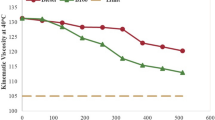Abstract
The effects of recirculated exhaust gas on the wear of cylinder liner and piston were experimentally investigated by a two-cylinder, four cycle, indirect injection diesel engine operating at 75% load and 1600 rpm. For the purpose of comparison between the wear rates of the two cylinders with and without EGR, the recirculated exhaust gas was sucked into one of two cylinders after the soot in exhaust emissions was removed by an intentionally designed cylinder-type scrubber equipped with 6 water injectors (A water injector has 144 nozzles of mm diameter), while only the fresh air was inhaled into the other cylinder. These experiments were carried out with the fuel injection timing fixed at 15.3° BTDC. It was found that the mean wear rate of cylinder liner with EGR was greater in the measurement positions of the second half than those of the first half, that the mean wear rate without EGR was almost uniform regardless of measurement positions, and that the wear rate of piston skirt with EGR increased a little bit, but the piston head diameter increased, rather than decreased, owing to soot adhesion and erosion wear, and especially larger with EGR.
Similar content being viewed by others
References
Andrews, G. E., Abdelhalim, S. M., and Li, H., 1999, “The Influence of Lubricating Oil Age on Oil Quality and Emissions from IDI Passenger Car Diesels,”SAE, 1999-01-1135, pp. 1–16.
Arcoumanis, C, Bae, C, Nagwaney, A., and White law, J. H., 1995, “Effect of EGR on Combustion Development in a 1. 9 L DI Diesel Optical Engine,”SAE 950850, pp. 169–193.
Bae, M., 1989, “A Study on the Soot Formation in Premixed Combustion at High Pressures (in Japanese),”Dissertation of TIT, pp. 96–105.
Bae, M., 1999, “A Study on the Effects of Recirculated Exhaust Gas on NOx and Soot Emissions in Diesel Engines with Scrubber EGR System,”SAE 1999-01-3266, pp. 78–87.
Bae, M., and Ha, J., 1999, “A Study on the Characteristics of Fuel Economy and Exhaust Emissions in Diesel Engines with Scrubber EGR System,”Proceedings of the 15th Internal Combustion Engine International Symposium, JSAE 9935536, pp. 287–292.
Bae, M., and Ha, J., 2000, “A Study on the Effect of Recirculated Exhaust Gas with Scrubber EGR System upon Exhaust Emissions in Diesel Engines,”Transactions of KSME (B), Vol. 24, No. 9, pp. 1247–1254.
Bae, M., and Kim, K., 1994, “A Study on Soot Formation in Premixed Constant-Volume Propane Combustion (Effects of Pressure, Ternperature and Equivalence Ratio)1994 KSME Journal, Vol. 8, No. 2, pp. 175–182.
Bae, M., Jeon, H., and Choi, J., 1999, “The Effects of Recirculated Exhaust Gas on Fuel Economy and Exhaust Emissions in Marine Diesel Engines,”Proceedings of CIMAC DA Y 1999 Shanghai — International Symposium on Internal Combustion Engine, pp. 91–105.
Dennis, A. J., Garner, C. P., and Taylor, D. H. C, 1999. “The Effect of EGR on the Diesel Engine Wear,”SAE, 1999-01-0839, pp. 45–57.
Furuhama, S., Suzuki, M., Ishikawa, H., and Watanabe, T., 1991, “The Primary Cause for Abnormal Wear in Diesel Engines with EGR Systems,”STLE, Tribology Transactions, Vol. 34, No. 1, pp. 86–92.
Gautam, M., Chitoor, K., Balla, S., and Keane, M., 1999, “Contribution of Soot Contaminated Oils to Wear-Part II,”SAE, 1999-01-1519, pp. 1–21.
Hiroyuki, N., and Koji, K., 1993, “Effects of S02 Concentration in Recirculated Exhaust Gas on Wear of Diesel Engines (Relationship Between Amount of S02 Absorbed into Oil Layer and Wear) (in Japanese),”Transactions of JSME (B), Vol. 59, No. 560, pp. 412–418.
Hiroyuki, N., and Koji, K., 1994, “Effects of SO2 Concentration in Recirculated Exhaust Gas on Wear of Diesel Engines (Effect of SO2 in Added to Intake Air on Wear) (in Japanese),”Transactions of JSME (B), Vol. 60, No. 572, pp. 402–408.
Kano, M., Tanimoto, I., Nakamura, K., and Fujiki, A., 1987, “The Effect of the EGR System on Valve Train Wear in Diesel Engine,”Transactions of Tribology, Vol. 32, No. 12, pp. 900–907.
Kitahara, F., Wakuri, Y., Hamatake, T., and Soejima, M., 1997, “Friction Characteristics of Piston and Piston Rings (in Japanese),”Proceedings of the 14th Internal Combustion Engine Symposium, pp. 391–396.
Lie, S., Li, J., Zhou, L., and Wei, R., 1996, “An Experimental Investigation of the Oil Film Lubricating Piston Rings,”SAE, 961912, pp. 33–37.
Murakami, Y., 1993, “Analysis of Corrosive Wear of Diesel Engines — Correlation between Engine Wear and Concentration of Sulfate Ion Extracted from Crankcase Oil (in Japanese),”Transactions of J SAE, Vol. 24, No. 1, pp. 119–125.
Narusawa, K., Odaka, M., Koike, N., Tsukamoto, Y., and Yoshida, K., 1990, “An EGR Control Method for Heavy Duty Diesel Engines under Transient Operations,”SAE, 900444, pp. 1–44.
Orii, N., 1995, “Lubricating Properties of Low Sulfur Diesel Fuel (in Japanese),”Journal of JSAE, Vol. 49, No. 5, pp. 79–83.
Sasaki, M., Kishi, Y., Hyuga, T., Okazaki, K., Tanaka, M., and Kurihara, I., 1997, “The Effect of EGR on the Diesel Engine Oil, and Its Countermeasures (in Japanese),”Proceedings of the 14th Internal Combustion Engine Symposium, pp. 379–383.
Shiozaki, T., and Suzuki, T., 1990, “Effect of EGR on Engine Performance and Emission of a DI Diesel Engine (in Japanese),”Transactions of JSAE, No. 46, pp. 18–23.
Shiozaki, T., Suzuki, T., and Otani, T., 1989, “Effect of EGR on Diesel Engine Performance and Its Problems (in Japanese)Hino Technical Review, No. 38, pp. 3–15.
Tani, M., and Sunada, S., 1994, “Improvement on Corrosive Wear of Cylinder Liners of Diesel Engines (in Japanese),”Journal of JSAE, Vol. 48, No. 5, pp. 41–46.
Urabe, M., Tomomatsu, T., Sato, K., and Takaguchi, M., 1998, “A Study of Piston Ring Wear and Frictional Force Under EGR Condition (in Japanese),”Transactions of JSAE, Vol. 29, No. 1, pp. 59–64.
Author information
Authors and Affiliations
Corresponding author
Rights and permissions
About this article
Cite this article
Bae, Mw., Tsuchiya, K. A study on effects of recirculated exhaust gas upon wear of cylinder liner and piston in diesel engines. KSME International Journal 15, 1524–1532 (2001). https://doi.org/10.1007/BF03185742
Received:
Revised:
Issue Date:
DOI: https://doi.org/10.1007/BF03185742




